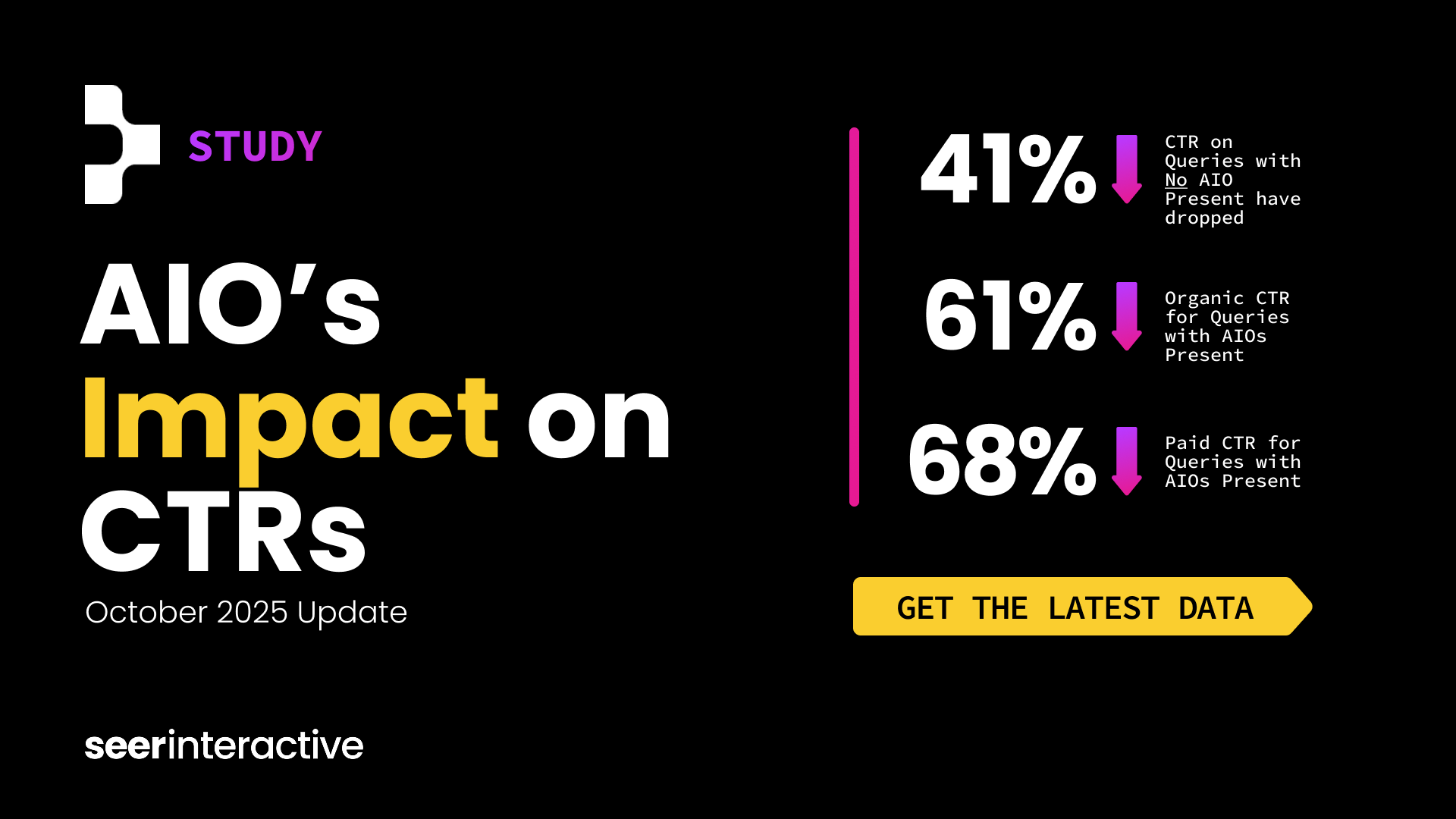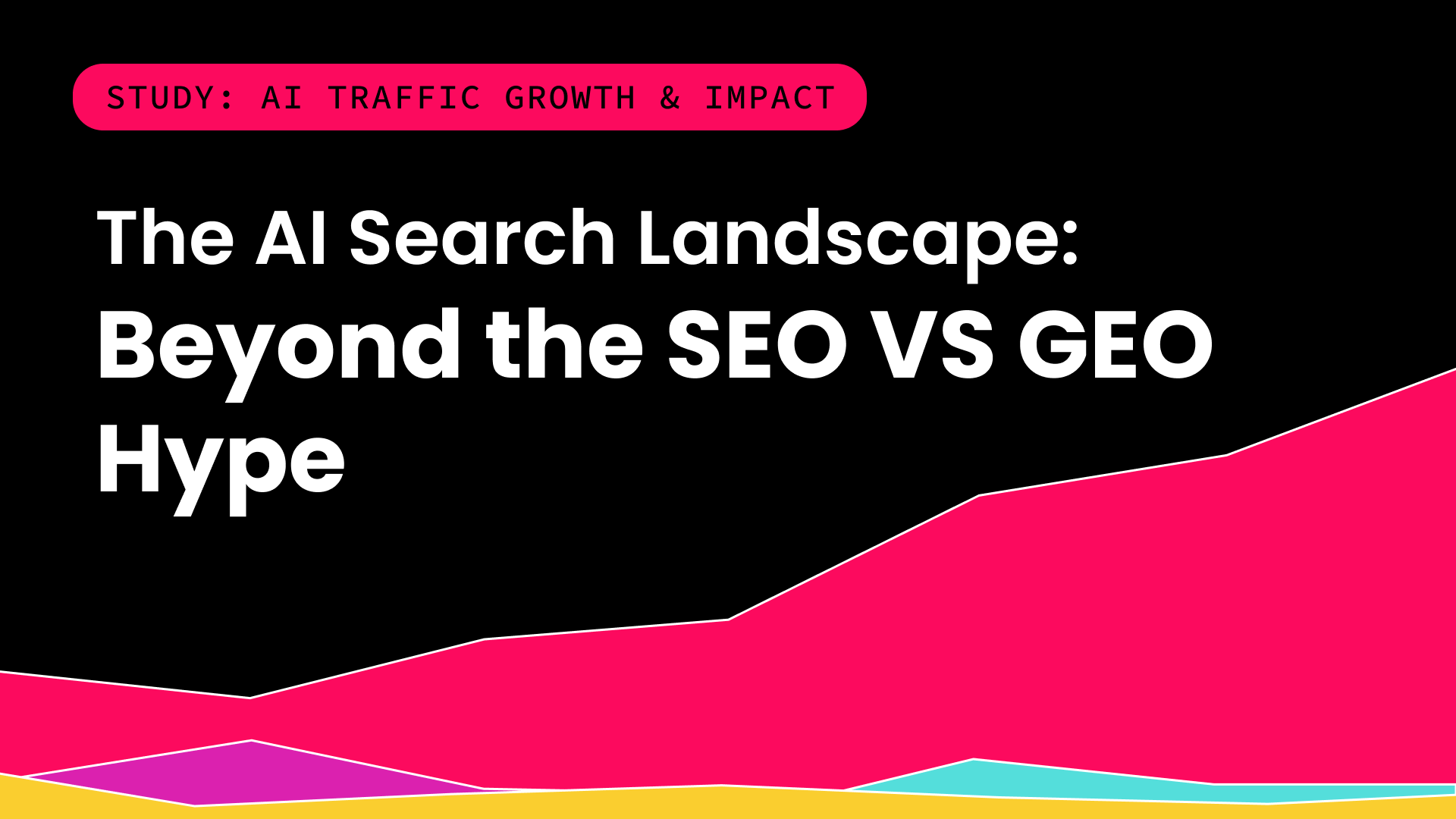If you’ve been following Seer Interactive in the last two years, you would know how big data and visualizing that data to provide insights has become our M.O. In all of our work, we are finding ways to uncover insights like we’ve never been able to before joining separate data sets together.
We were presented with the opportunity to analyze 4.19 million data points using data from our friends at Places Scout and STAT:

And of course, we put our Power BI hats on.
With this study, we had three main objectives:
- Identify and understand the most prominent local ranking factors
- Understand how proximity affects local rankings and how it changes by city and keyword grouping
- Dive into the changes around Local SERP features like People Also Ask questions and find commonalities among the types of questions asked
Just like any other project at Seer, we kicked off this process with audience research. Our Local SEO team met to develop our wish list of questions we’d want a local ranking factor study to answer.
From there, we set out to answer the following questions:
- What are the top correlated ranking factors for local SEO vs. traditional organic?
- What types of SERP features are showing up for local searches?
- How does proximity affect local rankings?
Ranking Factors
TL;DR: Some key takeaways about ranking factors:
- Ratings and reviews seem to be the difference-maker when it comes to breaking into the 3-pack.
- Links matter for both Maps and Localized Organic results, but more for Localized Organic Results.
- The closer a business is to the searcher’s location, the better it ranks.
What Ranking Factors Matter for the Local Pack?
Interestingly enough, our data and analysis revealed only two statistically significant relationships between measurable data points:
- Ratings: The higher a business’ rating, the better they rank.
- Review responses: Businesses that do not respond to reviews tend to rank lower. Does this mean that review response rate is a ranking factor? Maybe! But, maybe not. Businesses that respond to reviews regularly tend to be more involved in their Local SEO campaigns than those that don’t. It’s likely that an owner who takes the time to respond to every review left on their GMB profile has also taken the time to ensure that said profile is well-optimized, citations are in order, and their website is built in a way that makes it easy for Google and people to access its information.
Does that mean ratings and review responses are the ONLY two things driving businesses to rank in the 3-pack? Absolutely not. That just means that they were the only two factors where the correlation coefficient was large enough to deem factors statistically significant.
External linking root domains pointing to the domain associated with the GMB profile also slightly correlated to a higher rank, though not significantly.
What Ranking Factors Matter for the Local Finder (Google Maps)?
There were more statistically significant relationships between data points here; that’s to be expected, since there were more data points to analyze. Here, we were able to analyze the relationships between the top 20 ranking GMB profiles vs. only the top 3 in the Local Pack. Based on what we see, in many cases the difference between breaking into the 3-pack vs. only ranking in the Local Finder correlates to reviews and ratings.
Ranking Factors Specific to the Local Finder
(Positions 1-20)
Numbers of Linking Root Domains
Higher rank correlates with a higher number of linking root domains. The more linking root domains pointing to the site linked to your GMB listing, the more likely you are to rank:

Ratings
Higher ratings correlate to higher rankings:

Distance to Searcher’s Location
The closer a business is to the searcher’s location, the better it ranks. In our data set, the searcher’s location was also the center of the city zip code we analyzed:

What Ranking Factors Matter for the Localized Organic Results?
We utilized Moz’s link metrics to gauge the impact of a domain’s strength on its localized organic rankings. Keep in mind that Moz data isn’t directly factored into Google’s algorithm, but it’s a good proxy to trust to gauge the overall “strength” of a domain. We found that websites with a higher Domain Authority and Link Equity tend to rank better in localized organic results. This is especially true for the first two pages of Google; correlation declined as we moved deeper into the SERPs (page 3 and beyond).
Local SEO Ranking Factors When Comparing Cities or Industries
Are the same ranking factors important by category? How about by city?
It got more and more difficult to define overarching trends as we dove deeper into city-specific and category-specific analysis on this first pass. There were instances where certain categories in certain cities had more statistically significant relationships than others; and there were some instances where the data sets seemed to completely contradict each other. We believe this is based on the number of businesses listed in specific cities and industries, not the cities and industries themselves.
Take the “Financial Consultant” category in a few cities, for example:
| Ranking Factors for Localized Organic Results | Philadelphia, PA | Chicago, IL | Houston, TX |
| # of Keyword Occurrences in On-Page Copy |
Weak positive correlation |
No observed correlation |
No observed correlation |
| Total Words on Page |
No observed correlation |
Moderate negative correlation |
Very strong negative correlation |
| Photos |
Weak positive correlation |
Strong negative correlation |
Strong positive correlation |
| Title Tag Length |
Weak positive correlation |
Moderate negative correlation |
Strong positive correlation |
| Meta Description Length |
Weak positive correlation |
Moderate negative correlation |
No observed correlation |
| Distance from Searcher's Center |
Moderate negative correlation |
No observed correlation |
No observed correlation |
See? The “trend” is all over the place. What matters a lot for one city, doesn’t seem to matter for the next. “So nothing matters!” …Not quite. Like we said, we chalk this up to available inventory.
Now let’s look at “Tax Services” for the same sample cities:
| Ranking Factors for Localized Organic Results | Philadelphia, PA | Chicago, IL | Houston, TX |
|---|---|---|---|
| Photos |
Moderate positive correlation |
Strong positive correlation |
No observed correlation |
| Total Words on Page |
Moderate positive correlation |
No observed correlation |
Strong positive correlation |
| Title Tag Length |
Moderate positive correlation |
Moderate positive correlation |
Weak negative correlation |
| Meta Description Length |
No observed correlation |
Moderate negative correlation |
Moderate negative correlation |
| Page Load Time (ms) |
Strong positive correlation |
No observed correlation |
Weak positive correlation |
One could draw more common “trends” from this sample than from the Financial Consultant category above, but nothing here instills confidence that any of these factors are measurably more influential for Tax Services than Financial Consultants.
That said, with 4.19 million data points, there’s a lot to go through. We’ll keep digging into this data and will follow up if we find anything category- or city-specific worth sharing.
SERP Features
With Places Scout and STAT, we were able to cast a wide net when analyzing what features are commonly showing up within SERPs. These features didn’t just stop at the Local Pack, but ranged from video carousels to news to jobs. Below shows an example of some common SERP features:

When it comes to SERP features, besides the obvious Local Pack showing the most frequently, People Also Ask and Local Pack Ads are the next runners-up. In the visualizations below we broke down the percentage of each type of feature found within each keyword category. You’ll notice that other than the Local Pack, People Also Ask, and Local Pack Ads, features vary greatly depending on the category; however, this information can be used to help determine the types of features each industry should be optimizing for and the intent behind the search. For example, if you’re seeing a lot of PAA present, that’s an indicator that this search might be more informational and top-of-funnel. If you’re seeing lots of Local Pack Ads, that might be an indicator of a more competitive term.
SERP Features by Category
Check out the graphs below to see how often SERP features appear within each keyword category:
Accounting

Car / Auto Loans near me

Check Cashing / Services near me

Credit Counseling / Services (+city)

Financial Coach / Consultant (+city)

Home Mortgage (+city)
Investment Banking (+city)

Investment Services (+city)

Money Order Locations / Services (+city)

Money Transfer (+city)

Mortgage / Mortgage Lenders (+copy)

Small Business Loan (+city)

Tax Agent / Services near me

Working Capital Loan (+city)

Common People Also Ask Questions
What types of questions are showing up in People Also Ask? Check out the most common questions for each keyword category:
| Keyword Category | Most Common PAA's |
|---|---|
| Accountant |
|
| Accounting firm |
|
| Accounting services |
|
| Auto / car loans near me |
|
| Check cashing |
|
| Credit counseling |
|
| Financial coach / consultant |
|
| Financial planner / planning |
|
| Home mortgage |
|
| Investment banking |
|
| Money order locations / Money order service |
|
| Money transfer services |
|
| Mortgage |
|
| Mortgage lenders |
|
| Mortgage officer |
|
| Small business loan |
|
| Tax agent / Tax services |
|
| Working capital loan |
|
Impact of Proximity
TL;DR: Some key takeaways from looking at how proximity affects searches:
- Proximity from the person searching absolutely matters, and it’s clear in both the Local 3-Pack and Local Finder.
- Proximity averages vary greatly from city to city.
- City limits, transportation means, and drivability could affect how close proximity is for searches.
If you’ve been paying attention to any google local updates in the last few years, you may have noticed a great deal of articles and updates screaming “proximity is the #1 local search ranking factor.”💡
If content is king to SEO, then proximity is king to local SEO.
Proximity in Local 3-Pack vs. Local Finder Results
It’s abundantly clear that businesses no matter what city that shows up in the Local 3-Pack, will have a higher average proximity to businesses than compared to the Top 10 Local Finder results.
Almost unanimously the intent of the type of business the person was looking for, whether the business was a practitioner, local business, or service, the distance to the center for the search decreased when looking at averages of Local 3-Pack listings (Top 3) vs. Local Finder results (Top 10).
| Accountant [+city, near me] | Accountants near me | Accounting firm [+city] | Accounting services [+city] | Car loans near me, Autozones near me | Credit counseling [+city, near me] | Credit services [+city] | Financial coach [+city] | Financial consultant [+city] | Financial planner, Financial planning [+city] | |
|---|---|---|---|---|---|---|---|---|---|---|
| Local 3-Pack | ||||||||||
| Philadelphia | 1.0 | 0.8 | 1.0 | 1.4 | 24.6 | 1.4 | 1.2 | 6.3 | 7.5 | 0.6 |
| Jacksonville | 1.6 | 1.4 | 16.3 | 3.1 | 3.1 | 40.2 | 4.6 | 50.4 | 2.4 | 2.1 |
| Los Angeles | 1.0 | 0.9 | 1.2 | 1.5 | 29.7 | 1.0 | 4.0 | 5.3 | 2.0 | 0.9 |
| Chicago | 0.7 | 0.8 | 4.4 | 3.8 | 4.5 | 3.2 | 4.1 | 6.1 | 9.2 | 8.4 |
| Average | 1.1 | 1.0 | 5.8 | 2.4 | 15.5 | 11.4 | 3.5 | 17.0 | 5.3 | 3.0 |
| Accountant [+city, near me] | Accountants near me | Accounting firm [+city] | Accounting services [+city] | Car loans near me, Autozones near me | Credit counseling [+city, near me] | Credit services [+city] | Financial coach [+city] | Financial consultant [+city] | Financial planner, Financial planning [+city] | |
|---|---|---|---|---|---|---|---|---|---|---|
| Local Finder (Top 10) | ||||||||||
| Philadelphia | 5.6 | 10.4 | 7.6 | 8.3 | 2.2 | 2.2 | 10.6 | 286.0 | 12.6 | 1.5 |
| Jacksonville | 3.1 | 2.8 | 15.3 | 3.9 | 268.2 | 268.2 | 209.4 | 29.4 | 3.9 | 3.4 |
| Los Angeles | 1.6 | 1.6 | 2.4 | 2.6 | 4.0 | 4.0 | 4.5 | 6.3 | 2.8 | 1.9 |
| Chicago | 1.5 | 8.7 | 9.5 | 7.7 | 7.1 | 7.1 | 7.9 | 8.8 | 14.7 | 11.1 |
| Average | 2.9 | 5.9 | 8.7 | 5.6 | 70.4 | 70.4 | 58.1 | 92.6 | 8.5 | 4.5 |
💡
Proximity from the person searching absolutely matters, and it’s clear in both the Local 3-Pack and Local Finder.
Proximity Averages Vary Greatly from City to City
Something we found very interesting in this data set was the idea that averages for certain keyword groupings vary by city. We saw a lot of differences in the average proximity of searches when looking at keyword groupings against other cities.
For example, credit services keywords had an average of 1.2 miles average distance in the Local 3-Pack for Philadelphia, but across all other cities we saw the average as around 4 miles for the Local Finder.
When looking at accounting firm keywords, that average jumped from any variance of 1-16 miles for the Local 3-Pack across all 4 cities, with Philadelphia at an average of 1 mile and Jacksonville at 16.3 miles.
Often times in Local SEO, we don’t make inferences in terms of how much a city’s landscape, drivability, or even total mileage come into play—but after these numbers showed so much variation, it made us think. How do these affect proximity?
What Affects How Close Proximity Is for Search?
💡
City limits, saturation, transportation means, and drivability could affect how close proximity is for searches.
By far, the most overarching theme of this analysis is that there are very few overarching themes. This just highlights how important it is to pull your own data and conduct your own analysis on what works for YOUR industry in YOUR city.
| City | Average distance from center (3-pack) |
|---|---|
| Philadelphia | 2.3 |
| Jacksonville | 2.6 |
| Los Angeles | 2.0 |
| Chicago | 4.0 |
| Average | 2.7 |
| City | Average distance from center (local finder) |
|---|---|
| Philadelphia | 7.3 |
| Jacksonville | 5.3 |
| Los Angeles | 5.2 |
| Chicago | 8.6 |
| Average | 6.6 |
Distances for the keyword groups called out above ranged anywhere from 2.3–4 miles for Philly, LA, Jacksonville, and ChiTown, even when any possible data outliers were removed. For all Local Finder results that range from 5-9 miles when all possible data outliers were removed.
The average distance between the searcher and op-ranking businesses varied from city to city. So to make the claim that financial business listings “typically” have an average distance of anything would be a statement that is ultimately backed by zero data.
We do have some ideas of why this could be. The cities of Jacksonville, Philadelphia, Chicago, and Los Angeles all differ greatly in their access to public transportation, means of common transportation, and average city limits. Jacksonville happens to be the largest mileage city in the continental US. Los Angeles is vastly well known for its low access to public transportation and constant driving culture. Chicago is one of the largest financial hubs in the U.S., and Philadelphia is one of the top cities in terms of public transportation.
Personalized Analysis Will Give You the Answers You Seek
If you came here for “Do This And Rank Better”-type of direction, sorry, you’re out of luck. And we imagine some of you might be frustrated by the lack of prescriptive direction in this analysis.
If we learned anything from this deep dive, it’s that “industry benchmarks” are at best directional, and at worst completely inaccurate. Our recommendation after all of this is to stop building your strategy off of someone else’s analysis. Pull the data yourself, crunch your own numbers, and figure out what works for you against your competitors. Revisit it often and always keep a pulse on the shifting landscape. And don’t @ us if you disagree until you show us data that proves us wrong. 😄
This lab was written by:
- Cori Graft, Associate Director, SEO
- Jackie Schluth, Sr. Manager, SEO
- Tracy McDonald, Sr. Manager, R&D
- Christina Miazgowicz (Alumni)
- Ekom Enyong (Alumni)
- Greta Hartsell (Alumni)
.png)



